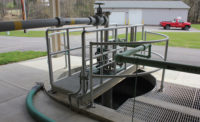PEX (crosslinked polyethylene) piping is becoming increasingly accepted and specified on commercial plumbing projects because of its flexibility, physical properties and ability to retain the most preferential aspects of metallic piping while improving upon them.
Still, many engineers are hesitant to specify PEX simply because metallic systems have been the norm for so long and often are the default option. However, playing it safe is rarely the ideal option, and a greater understanding of how best to design and size a PEX installation can do much to overcome this hesitation.
PEX also offers substantial benefits over metallic piping for in-slab applications. It requires fewer fittings, can avoid obstructions with its flexibility and reduces necessary labor for hangers. Bare PEX is listed for use in concrete as well as below-grade and water-service applications.
Thermal expansion and contraction
PEX pipe expands and contracts at a rate of 1.1 in. per 100 ft. per 10° F Delta-T. Utilizing pipe supports with PEX for suspended-piping applications in conjunction with fixed anchor points can reduce this expansion and contraction rate to a more than acceptable level.
When using pipe supports, be sure to use a minimum 300-lb., tensile-rated, stainless-steel strap to secure the support to the pipe. Place fixed anchor points at 65 ft. for domestic hot water and 150 ft. for domestic cold water.
With a loop or clevis system, using pipe supports and fixed anchor points reduces the expansion-contraction rate to 0.12 in. per 100 ft. per 10° Delta-T, or by 89%.
In a strut system, the same procedure reduces the expansion-contraction rate to 0.08 in. per 100 ft. per 10° Delta-T, a 93% reduction. This rate actually is less than that for copper, which is 0.11 in. per 100 ft. per 10° Delta-T.
For risers, use a copper tube size (CTS) riser clamp on the base of each floor to control for expansion and contraction. In hot-water applications, add an extra clamp at the top of every other floor; for cold water, add one at the top of every fourth floor. Mid-story guides also are required by most code bodies and should consist of an iron pipe size support and are meant to guide the pipe and maintain direction.
Pipe sizing
PEX pipe is manufactured with a CTS outside diameter and a standard dimension ratio of nine (9). The SDR is a correlation between the pipe’s outside diameter and wall thickness. This allows PEX to use the same hangers and supports used with copper, as well as any CTS insulation. PEX-a pipe is burst tested at an elevated pressure and all pipe sizes will burst in the 800 psi range, nearly double the minimum requirement of ASTM F876 Standard Specification for Crosslinked Polyethylene (PEX) Tubing. Figure C shows the temperature and pressure ratings.
For design purposes, it is important to understand the various types of fitting connections available for PEX pipe:
- ASTM F1807 Standard Specification for Metal Insert Fittings Utilizing a Copper Crimp Ring for SDR9 Cross-linked Polyethylene (PEX) Tubing and SDR9 Polyethylene of Raised Temperature (PE-RT) Tubing;
- ASTM F2159 Standard Specification for Plastic Insert Fittings Utilizing a Copper Crimp Ring for SDR9 Cross-linked Polyethylene (PEX) Tubing and SDR9 Polyethylene of Raised Temperature (PE-RT) Tubing;
- ASTM F2098 Standard Specification for Stainless Steel Clamps for Securing SDR9 Cross-linked Polyethylene (PEX) Tubing to Metal Insert and Plastic Insert Fittings;
- ASTM F877 Standard Specification for Crosslinked Polyethylene (PEX) Plastic Hot- and Cold-Water Distribution Systems; and
- ASTM F1960 (ProPEX) Standard Specification for Cold Expansion Fittings with PEX Reinforcing Rings for Use with Cross-linked Polyethylene (PEX) Tubing.
When specifying fittings, one must design with the same system intended to be used in the application. If an engineer specifies a PEX system with F1960 fittings, but the contractor installs any of the alternatives, system velocity — and therefore performance — will be significantly impacted.
ASTM F1960 fittings are, in many cases, preferred over alternate fitting connections. In an F1960 connection, the installer simply uses an expansion tool to expand the PEX-a pipe and PEX-reinforcing ring before inserting a fitting. As the ring and pipe shrink back down to their original size, it creates a strong, durable connection that holds tight with up to 1,500 psi of radial force. A 1-in. F1960 engineered polymer fitting has a 67% greater flow rate at 8 ft. per second than a F2159 plastic fitting and 22% greater flow rate than a F1807 brass fitting.
When it comes to compiling friction loss data, using the Darcy-Weisbach formula is much more accurate and does not employ correction factors for different water temperatures such as Hazen Williams. Friction loss data compiled by Uponor utilizes this method and has been backed by empirical NSF laboratory test data, making it an excellent free resource for maximizing system sizing and efficiency.
There are three ways to size a PEX piping system with ASTM F1960 (ProPEX) fittings. The first is to use model code fixture unit tables (Figure D). Of course, this method applies only to systems whose scopes fall within the table.
IAPMO and ICC have confirmed compliance with using fixture unit tables to determine pipe size for systems utilizing the ProPEX fitting system, which complies with ASTM F1960.
A second method involves residual pressure, which determines the critical path by the most remote or demanding fixture. Utilize friction-loss data and calculate system loss from the fixture to the source, ensuring a PEX replacement provides sufficient pressure. The result may require up-sizing high-loss cold-water pipe segments. However, it may be possible to downsize some hot-water pipe segments due to the difference between the design velocities of copper and PEX.
Finally, a third method of sizing pipe is the uniform friction loss method. This method utilizes the physical layout of the structure to determine pipe sizes. Information such as available static pressure, building height and distance to the farthest fixture are required to complete this calculation. Once this data is compiled, the designer will determine a pressure loss per 100-ft. (or per foot) number by dividing the total developed length by the pressure available for loss (Figure E). This number is then used to create water supply fixture unit tables for each pipe material and water temperature (Figure F).
Admittedly, many contractors may feel that switching to PEX constitutes a great risk. After all, traditional piping materials work just fine, and most professionals are accustomed to designing and sizing a project with them.
However, sometimes great risks lead to even greater rewards and PEX pipe’s qualities and design aspects might be beneficial enough to one day become the new norm.






